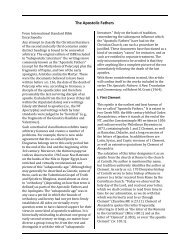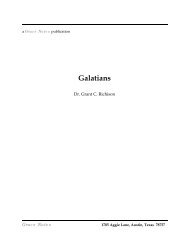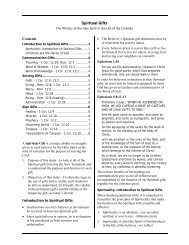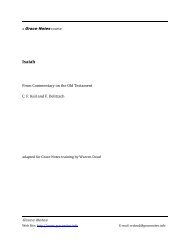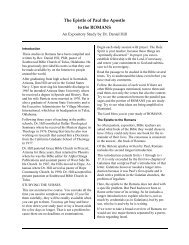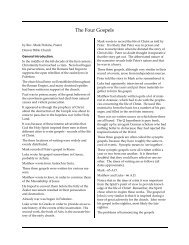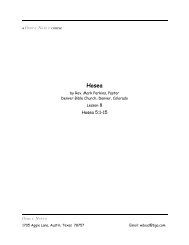Song of Solomon - Grace Notes
Song of Solomon - Grace Notes
Song of Solomon - Grace Notes
Create successful ePaper yourself
Turn your PDF publications into a flip-book with our unique Google optimized e-Paper software.
SONG OF SOLOMON Page 45By C. F. Keil and F. Delitzscha <strong>Grace</strong> <strong>Notes</strong> studyחֲ תֻ נָ ה following. determined by the relat. clauseis the marriage (the word also used in the postbibl.Heb., and interchanging with פָ ה ,חֻ properlyυ φώ , Matt. 9:15), from the verb תַ ן ,חָ which,proceeding from the root-idea <strong>of</strong> cutting into,חָ תַ ְך whence ,חת R. (Arab. khatn, to circumcise;denotes the pressing into, or going ,(חָ תַ ר ,חָ תַ םinto, another family; חָ טַ ן is he who enters intosuch a relation <strong>of</strong> affinity, and חֹתֵ ן the father <strong>of</strong>her who is taken away, who also on his part isrelated to the husband. Here also the seductionfable is shattered. The marriage with Shulamithtakes place with the joyful consent <strong>of</strong> thequeen-mother. In order to set aside this fatalcircumstance, the “crown” is referred back tothe time when <strong>Solomon</strong> was married toPharaoh’s daughter. Cogitandus est Salomo, saysHeiligst., qui cum Sulamitha pompa sollemniHierosolyma redit, eadem corona nuptialiornatus, qua quum filiam regis Aegyptiorumuxorem duxeret ornatus erat. But was he then sopoor or niggardly as to require to bring forththis old crown? and so basely regardless <strong>of</strong> hislegitimate wife, <strong>of</strong> equal rank with himself, as towound her by placing this crown on his head inhonour <strong>of</strong> a rival? No; at the time when thisyouthful love-history occurred, Pharaoh’sdaughter was not yet married. The mention <strong>of</strong>his mother points us to the commencement <strong>of</strong>his reign. His head is not adorned with a crownwhich had already been worn, but with a freshgarland which his mother wreathed around thehead <strong>of</strong> her youthful son. The men have alreadywelcomed the procession from afar; but theking in his wedding attire has specialattractions for the women—they are herecalled upon to observe the moment when thehappy pair welcome one another.<strong>Song</strong> <strong>of</strong> <strong>Solomon</strong> 4Second Scene <strong>of</strong> the Third Act, 4:1–5:1This scene contains a conversation between<strong>Solomon</strong> and his beloved, whom he at first callsfriend, and then, drawing always nearer to her,bride. The place <strong>of</strong> the conversation is, as 5:1shows, the marriage hall. That the guests thereassembled hear what <strong>Solomon</strong> says toShulamith, one need not suppose; but the poethas overheard it from the loving pair. Fairerthan ever does Shulamith appear to the king. Hepraises her beauty, beginning with her eyes.1a Lo, thou art fair, my friend! yes, thou artfair!Thine eyes are doves behind thy veil.<strong>Song</strong> 4:1. The Gr. Venet. translates, afterKimchi, “looking out from behind, thy hairflowing down from thy head like a mane.” Thusalso Schultens, capillus plexus; and Hengst., whocompares πλέγ , 1 Tim. 2:9, and ἐ πλ ὴχῶ , 1 Pet. 3:3, passages which do not accord,צָ מַ ם with the case <strong>of</strong> Shulamith; but neitherArab. ṣmm, nor ṭmm signifies to plait; the latteris used <strong>of</strong> the hair when it is too abundant, andready for the shears. To understand the hair asdenoted here, is, moreover, inadmissible,inasmuch as מבעד cannot be used <strong>of</strong> the eyes inrelation to the braids <strong>of</strong> hair hanging beforethem. Symm. rightly translates צמה by άλυ[veil] (in the <strong>Song</strong> the LXX erroneously rendersby σ π σε ς [behind thy silence]), Isa. 47:2.The verb מַ ם ,צָ (Arab.) ṣmam, a stopper, and(Arab.) alṣamma, a plaid in which one veilshimself, when he wraps it around him. The veilis so called, as that which closely hides the face.In the Aram. מַ ם ,צְׁ Palp. , means directly toveil, as e.g., Bereshith rabba c. 45, extr., <strong>of</strong> amatron whom the king lets pass before him it issaid, פניה .צימצמה Shulamith is thus veiled. Asthe Roman bride wore the velum flammeum, soalso the Jewish bride was deeply veiled; cf. Gen.24:65, where Rebecca veiled herself (Lat. nubit)before her betrothed. עַ ד ,בַ constr. עַ ד ,בְׁ asegolate noun, which denotes separation, is aprep. in the sense <strong>of</strong> pone, as in Arab. in that <strong>of</strong>post. Ewald, sec. 217m, supposes, contrary tothe Arab., the fundamental idea <strong>of</strong> covering(cogn. ;(בגד but that which surrounds is thought<strong>of</strong> as separating, and at the same time ascovering, the thing which it encompasses. Frombehind her veil, which covered her face (vid.,צַ מְׁ צֵ ם



